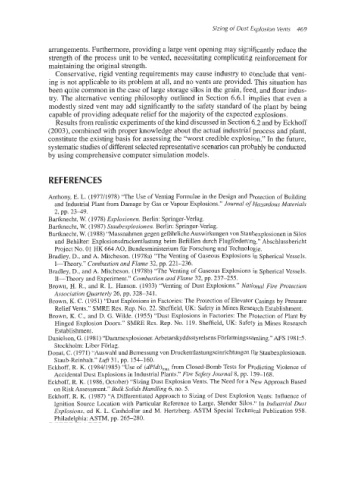Page 502 - Dust Explosions in the Process Industries
P. 502
Sizing of Dust Explosion Vents 469
arrangements. Furthermore,providing a large vent opening may significantlyreduce the
strength of the process unit to be vented, necessitating complicating reinforcement for
maintaining the original strength.
Conservative, rigid venting requirements may cause industry to conclude that vent-
ing is not applicable to its problem at all, and no vents are provided. This situation has
been quite common in the case of large storage silos in the grain, feed, and flour indus-
try. The alternative venting philosophy outlined in Section 6.6.1 implies that even a
modestly sized vent may add significantly to the safety standard of the plant by being
capable of providing adequate relief for the majority of the expected explosions.
Results from realistic experimentsof the kind discussed in Section6.2 and by Eckhoff
(2003), combined with proper knowledge about the actual industrial process and plant,
constitute the existing basis for assessing the “worst credible explosion.” In the future,
systematicstudiesof differentselected representativescenarios can probably be conducted
by using comprehensive computer simulation models.
REFERENCES
Anthony, E. L. (1977/1978) “The Use of Venting Formulae in the Design and Protection of Building
and Industrial Plant from Damage by Gas or Vapour Explosions.” Journal ofHazardous Materials
2, pp. 23-49.
Bartknecht, W. (1978) Explosionen. Berlin: Springer-Verlag.
Bartknecht, W. (1987) Stuubexplosionerz. Berlin: Springer-Verlag.
Bxtknecht, W. (1988) “Massnahmen gegen gefahrlicheAuswirkungen von Staubexplosionen in Silos
und Behalter: Explosionsdruckentlastung beim Befullen durch Flugfordening.” Abschlussbericht
Project No. 01 HK 664 AO, Bundesministerium fur Forschung una Technologie.
Bradley. D., and A. Mitcheson. (1978a) “The Venting of Gaseous Explosions in Spherical Vessels.
I-Theory.’’ Combustion and Flame 32, pp. 221-236.
Bradley, D., and A. Mitcheson. (1978b) “The Venting of Gaseous Explosions in Spherical Vessels.
11-Theory and Experiment.” Combustion and Flame 32, pp. 237-255.
Brown, H. R., and R. L. Hanson. (1933) “Venting of Dust Explosions.” National Fire Protection
Association Quarterly 26, pp. 328-341.
Brown, K. C. (1951) “Dust Explosions in Factories: The Protection of Elevator Casings by Pressure
Relief Vents.” SMRE Res. Rep. No. 22. Sheffield, UK Safety in Mines Research Establishment.
Brown, K. C., and D. G. Wilde. (1955) “Dust Explosions in Factories: The Protection of Plant by
Hinged Explosion Doors.” SMRE Res. Rep. No. 119. Sheffield, UK: Safety in Mines Research
Establishment.
Dmielson, G. (1981) “Dammexplosioner.ArbetarskyddsstyrelsensForfattningssamling.” AFS 1981:5.
Stockholm: Liber Forlag.
Donat, C. (1971) “Auswahl und Bemessung von Druckentlastungseinrichtungenfur Staubexplosionen.
Staub-Reinhalt.” Luft 31, pp. 154-160.
Eckhoff, R. K. (1934/1985) “Use of (dP/dt),, from Closed-Bomb Tests for Predicting Violence of
Accidental Dust Explosions in Industrial Plants.” Fire Safely Journal 8, pp. 159-168.
Eckhoff, R. K. (1986, October) “Sizing Dust Explosion Vents. The Need for a New Approach Based
on Risk Assessment.” Bulk Solids Handling 6, no. 5.
Eckhoff, R. K. (1987) “A Differentiated Approach to Sizing of Dust Explosion Vents: Influence of
Ignition Source Location with Particular Reference to Large, Slender Silos.” In Industrial Dust
Explosions, ed K. L. Cashdollar and M. Hertzberg. ASTM Special Technical Publication 958.
Philadelphia: ASTM, pp. 265-280.

